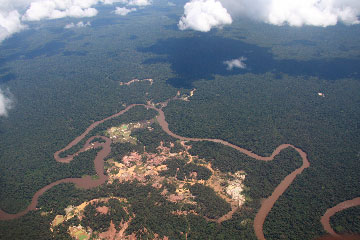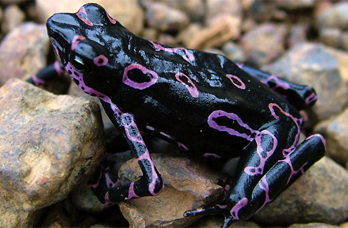A prominent group of biologists are calling for Alcoa, Newmont Mining Corp, and other minerals conglomerates to forgo gold and bauxite mining operations in a biologically-rich zone in the South American country of Suriname.
In a resolution issued last week, the Association for Tropical Biology and Conservation (ATBC) warned that mining on the Nassau Plateau, a 400-square-kilometer area of unprotected rainforest, would destroy habitats that support rare and endemic species — including several newly discovered species (catfish, frogs, and a stunning purple toad). Mining operations would further encourage the influx of wildcat gold miners in the area, increasing environmental damage and putting pressure on wildlife, the resolution said.
 Gold mining in Suriname.  A previously unknown species of Atelopus toad discovered on the Nassau plateau in Suriname. Atelopus toads have been particularly affected by the deadly chytrid fungus. Photo © Paul Ouboter |
“The Nassau Plateau is in the southern portion of the area projected to be exploited by the massive Merian Gold Project, a venture of Surgold (Suriname Gold Company) managed by Newmont Oversees Exploration, a subsidiary of the USA-based Newmont Mining Corporation and Alcoa Worldwide Alumina,” stated the resolution, notinh that while Alcoa originally back off plans to fine the area, it is now showing renewed interest.
“A fact sheet on the Merian Gold Project states that habitats above 100 meters elevation will not be exploited for gold, but provides no indication of measures needed to protect habitats at higher elevations from small-scale mining, hunting, and collecting, all of which can have serious long-term impacts on rainforest ecosystems and wildlife,” continued the resolution. “Illegal gold-mining operations and hunting have risen dramatically around the Nassau Plateau since the late 1990s.”
The resolution calls for a ban on large- and small-scale mining of gold and bauxite from Nassau Plateau and its immediate surroundings as well as protective status for the area. It also urges educational outreach programs to inform the Suriname public “about the importance of protecting natural habitats and watersheds for their continued health, recreation, and national heritage.”
With members in over 70 countries, ATBC is the world’s largest scientific organization devoted to the study and protection of tropical ecosystems.
RESOLUTION OPPOSING INDUSTRIAL MINING DEVELOPMENT AT NASSAU, SURINAME
More about the Nassau Plateau
Related articles
Scientists call for mining ban, new protected areas in Suriname
(06/20/2008)
In a resolution set forth at their annual meeting in Paramaribo, Suriname, the largest group of tropical biologists called upon the Surinamese government to evict informal gold miners from three ecologically important areas in the South American country. Miners have been blamed for a number of environmental problems including over-hunting of wildlife, deforestation and destruction of riparian habitats, erosion, and mercury pollution in waterways.
France blocks controversial rainforest gold mine in French Guiana
(02/06/2008)
Environmentalists declared victory after the French government blocked approval of a controversial gold mine bordering the Kaw wetland, an ecologically rich site in French Guiana. The decision was handed down last week following an environmental assessment by the Ministry of Ecology and Sustainable Development based on work by local scientists.
Proposed gold mine proves controversial in French Guiana rainforest
(11/07/2007)
Commercial gold mining threatens a key forest reserve and wetland in French Guiana say scientists who warn that exploitation could pollute rivers with toxic compounds, threaten wildlife, and put indigenous populations at risk.
Pictures of newly discovered species in Suriname
(06/04/2007)
Scientists documented 467 species, including 24 species believed new to science, during a rainforest survey in eastern Suriname, South America. The expedition, led by conservation International (CI), was sponsored by two mining companies, BHP-Billiton Maatschappij Suriname (BMS) and Suriname Aluminium Company LLC (Suralco), hoping to mine the area for bauxite, the raw material used to make aluminum. conservation International said the Rapid Assessment Survey (RAP) will help “give miners guidance on protecting unique plants and animals during potential future development,” according to a statement from the organization.
Gold mining in Guyana damages environment, threatens Amerindians
(03/06/2007)
Informal gold mining is causing environmental harm and human rights abuses in Guyana says a new report from the International Human Rights Clinic (IHRC) of Harvard Law School’s Human Rights Program. Wildcat gold mining has been a serious problem in the Guiana shield countries of Brazil, Venezuela, Guyana, Suriname and French Guiana. Rising gold prices in recent years have only worsened the problem, as illegal miners have flooded the region clearing forest, polluting rivers, and making threats against indigenous people.
Europe’s largest tropical rainforest invaded by gold miners
(12/19/2006)
As Europe frets over climate change and deforestation, threats to “Europe’s largest tropical rainforest” are mounting, according to reports from French Guiana. While French Guiana is best known for its infamous Devil’s Island penal colony and as the main launch site for the European Space Agency, which is responsible for more than 50% of the state’s economy activity, most of the territory is covered with lowland tropical rainforest. French Guiana’s forests are biologically rich with some 1,064 known species of amphibians, birds, mammals and reptiles, and 5,625 species of vascular plants according to figures from the World conservation Monitoring Center.
Mining in Venezuelan Amazon threatens biodiversity, indigenous people
(11/09/2006)
Troubles are mounting in one of Earth’s most beautiful landscapes. Deep in the Venezuelan Amazon, among ancient forested tabletop mountains known as tepuis, crystalline rivers, and breathtaking waterfalls, illegal gold miners are threatening one of world’s largest remaining blocks of wilderness, one that is home to indigenous people and strikingly high levels of biological diversity. As the situation worsens — a series of attacks have counted both miners and indigenous people as victims — a leading scientific organization has called for the Venezuelan government to take action.
Whereas Suriname, located in the unique Guiana Shield region, is one of the few remaining tropical nations with a low population density and large expanses of relatively undisturbed rainforest and other rare ecosystems that could be conserved for future generations; and
Whereas Suriname has been a pioneer in nature conservation since the mid-20th century and, in 2000, established the 16,000 square-kilometer Central Suriname Nature Reserve, a UNESCO World Heritage Site; and
Whereas the isolated bauxite plateaus of northeastern Suriname—at Brownsberg, Lely, and Nassau—constitute a rare and imperiled landform (early Tertiary denudation surface or peneplain) that represents less than 0.5% of the Suriname land area and that harbors the highest diversity of trees, bromeliads, orchids, and some other plant groups known in Suriname; and
Whereas, in 2002, an environmental priority-setting workshop in Paramaribo identified the Maroni Area, including Brownsberg, Lely, and Nassau, as having the highest possible biological importance and as being extremely vulnerable to environmental pressures from mining and hunting; and
Whereas the Association for Tropical Biology and Conservation previously adopted, during its 2008 annual meeting in Paramaribo, a formal Declaration urging establishment of permanent protected-area status for the Brownsberg, Nassau, and Lely areas; and
Whereas the Nassau Plateau, an area of just 400 square kilometers, is the most threatened of the three bauxite plateaus because of its high accessibility and lack of protected-area status; and
Whereas the Nassau Plateau is in the southern portion of the area projected to be exploited by the massive Merian Gold Project, a venture of Surgold (Suriname Gold Company) managed by Newmont Oversees Exploration, a subsidiary of the USA-based Newmont Mining Corporation and Alcoa Worldwide Alumina; and
Whereas a fact sheet on the Merian Gold Project states that habitats above 100 meters elevation will not be exploited for gold, but provides no indication of measures needed to protect habitats at higher elevations from small-scale mining, hunting, and collecting, all of which can have serious long-term impacts on rainforest ecosystems and wildlife; and
Whereas illegal gold-mining operations and hunting have risen dramatically around the Nassau Plateau since the late 1990s; and
Whereas initial biological surveys in the Nassau area have found several new catfish and frog species previously unknown to science, at least some of them locally endemic to the Nassau Plateau, indicating that knowledge of the region is far from complete, and suggesting that future biological surveys will yield many more rare and endemic species; and
Whereas Nassau’s endemic catfishes are restricted in their distribution to the headwaters of a single, pristine mountain stream, Paramaka Creek, fed by perennial springs; and
Whereas the multinational corporation Alcoa (Suralco) has shown renewed interest in mining bauxite at Nassau, despite previously pledging not to mine there because of its limited bauxite deposits, the logistical complications of transporting the bauxite to the Paranam refinery, and serious environmental concerns; and
Whereas mining of Nassau bauxite deposits would (1) destroy the plateau forest in the catchment of Paramaka Creek, which provides critical habitat for endemic aquatic and riparian species at Nassau, thereby degrading stream-water quality via elevated turbidity and sedimentation and (2) remove the aquifer system of porous bauxite-rock, thereby increasing the likelihood of stream failure in the Paramaka Creek in the dry season;
Therefore, be it resolved that the Association for Tropical Biology and Conservation respectfully requests that the Government of the Republic of Suriname and Alcoa Corporation to urgently take necessary steps to protect the unique natural heritage of Nassau Plateau, including:
Halting all activities directed toward establishment of a bauxite mine in Nassau Plateau; and
Instituting a ban on large- and small-scale mining of gold and bauxite from Nassau Plateau and its immediate surroundings; and
Taking active measures to protect the watershed of Paramaka Creek; and
Designating the Nassau Plateau area as a National Protected Area and establishing guidelines for management of its natural resources; and
Encouraging scientists at Anton de Kom University to establish a long-term monitoring project for endangered species in the Nassau area, and to explore the site for new species; and
Establishing educational programs to inform the Suriname public, particularly those in Paramaribo, about the importance of protecting natural habitats and watersheds for their continued health, recreation, and national heritage.